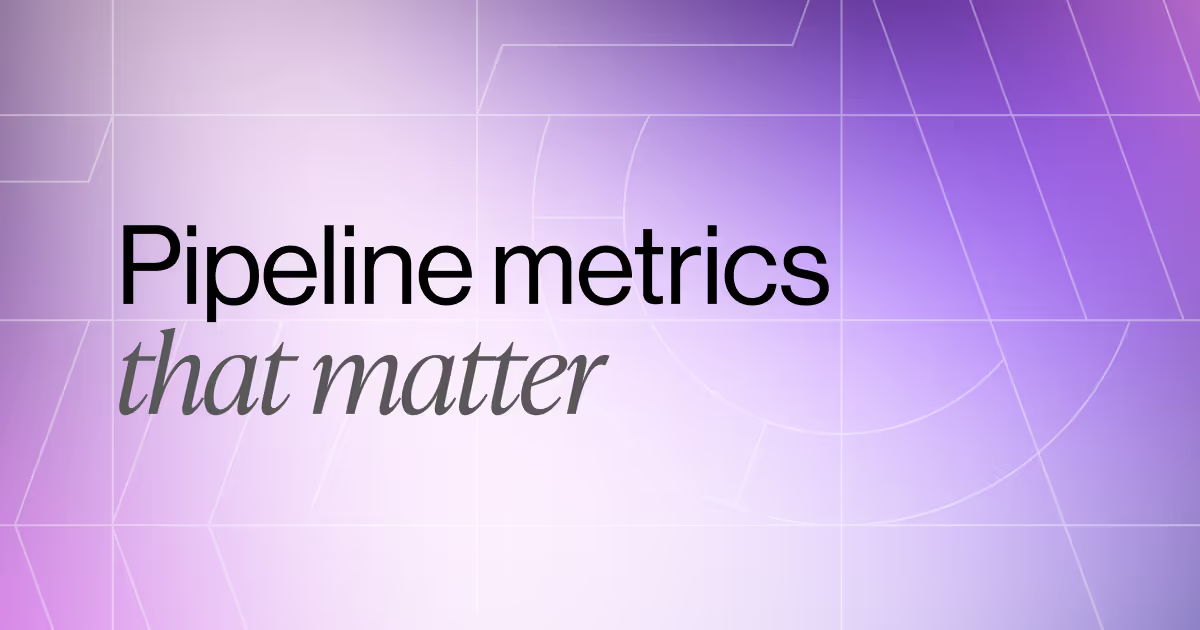B2B Sales Pipeline: Complete Guide to Building and Managing Complex Sales Processes
In B2B sales, the stakes are higher, the deals are larger, and the cycles are considerably longer than in most B2C sales. To make things more challenging, a pipeline that looks healthy on paper can mask stalled opportunities and stakeholder indecision, both of which can drag your forecast off course.
A strong B2B sales pipeline needs to reflect the reality of these complex buying decisions. That means creating stages that account for multiple stakeholders, tracking metrics that show true momentum and uncover any gaps that need addressing, and aligning your team’s efforts with incentives that keep motivation high. When you do, your pipeline becomes a reliable driver of revenue growth.
What Makes B2B Sales Pipelines Different?
B2B pipelines aren’t built on quick transactions or one-off purchases like many B2C sales processes are. They’re often designed for long, relationship-driven processes where the path to closed-won is anything but linear. Understanding these differences is the first step in building a pipeline that works for your B2B business.
Multiple Decision-Makers and Influencers
One of the defining traits of B2B sales is the number of people involved in the buying process. It’s not unusual to see six, eight, or even 10 stakeholders influencing the final decision. Each stakeholder has their own priorities. Finance cares about budget impact, IT evaluates technical fit, and executives weigh strategic alignment with corporate goals. This makes consensus-building a critical stage of the sales pipeline, because unless every key stakeholder is on board, the deal is unlikely to move forward.
Longer Sales Cycles
While a B2C purchase might take minutes or days, B2B sales cycles often stretch for weeks or months. Some enterprise deals can even last a year, depending on the procurement calendar and the strategic value of the deal. Every stage of the pipeline requires more touches and more validation to keep deals moving. For sales leaders, that makes pipeline velocity a key indicator. It’s not enough to just have opportunities in play — you need to know how quickly they’re progressing and where in the pipeline they’re slowing down. Capturing and acting on this insight is what separates predictable pipelines from ones that perpetually over-promise and under-deliver.
Higher Deal Values
In B2B sales, the value of a single deal can represent a significant portion of annual revenue. That makes pipeline management a high-stakes exercise — losing one opportunity can dramatically alter your forecast. The upside is that getting pipeline management right can help your business scale and meet (or exceed) your revenue goals. This is also why leaders can’t afford to treat all opportunities equally. Pipeline mix has to be deliberate, balancing high-value accounts with mid-tier deals that keep revenue predictable.
Complex Product or Service Offerings
Most B2B purchases aren’t one-size-fits-all. Whether you’re selling SaaS, professional services, manufacturing equipment, or warehousing, buyers expect solutions tailored to their needs. That introduces technical assessments, customization discussions, and integration considerations into the sales process. A well-structured pipeline accounts for these complexities, ensuring that reps know when to bring in specialists and how to keep momentum going without overwhelming the buying group.
Relationship-Driven Sales Process
At the heart of B2B sales is trust. Buyers want a partner who understands their business and will stand by them through implementation and beyond. That’s why strong relationships are a pipeline necessity in B2B. A well-designed pipeline gives sellers the framework to prioritize consistent engagement and deeper discovery, which lays the foundation for trust and conversion.
B2B Sales Pipeline Stages
The structure of your pipeline should mirror the complexity of your sales process. Each stage should represent a meaningful step in the buyer’s journey, giving sellers a clear roadmap and leaders full visibility into deal health. Below are eight core stages most B2B pipelines should include, with space to adapt them to your unique business.
1. Account Research and Prospecting
A sales pipeline begins with identifying the right accounts. In B2B sales, volume matters less than fit, because you want your sales reps spending their time on leads that are more likely to convert. Reps should focus on accounts that align with the industries, size, or strategic value of your ideal customer profile (ICP). Account-based marketing (ABM) strategies that target specific companies often come into play here, helping teams prioritize quality over quantity. Skipping this discipline often clogs the pipeline with low-quality leads, creating a false sense of momentum that rarely translates into revenue.
2. Initial Contact and Qualification
Once a prospect is identified, the first conversations determine whether they truly belong in your pipeline. Qualification frameworks like BANT (budget, authority, need, timeline) or GPCTBA/C&I (goals, plans, challenges, timeline, budget, authority/negative consequences and positive implications) help ensure reps are pursuing opportunities worth their time. For example, an inbound lead that attends a webinar may appear promising, but without budget, company size, industry alignment, or decision-making authority, it could just add to the noise. A rigorous qualification process reduces wasted effort for your sales team and creates a healthier, more accurate pipeline.
3. Discovery and Needs Assessment
Discovery is where consultative selling shines. Here, reps go beyond the surface-level conversation to uncover the real challenges the prospect is dealing with. By asking the right questions and actively listening, sellers can position their offering as a tailored solution. Otherwise, reps risk presenting a solution that solves the wrong problem. This stage often requires multiple calls and, when done right, can go a long way in establishing trust with the prospect.
4. Solution Design and Presentation
Equipped with insights from the discovery stage, reps can collaborate internally with technical specialists and other team members to design a solution that addresses the prospect’s needs. The presentation of this solution must balance technical depth with business value, making the case to both end users, executives, and anyone else on the buying committee. This stage often includes demos, proofs of concept, or pilot programs that give the buying group confidence in the proposed solution.
5. Stakeholder Buy-In and Consensus
This is often the most challenging stage of a B2B pipeline. Even if individual stakeholders are convinced, the buying group has to align around a shared decision. From the very beginning of the sales pipeline, your reps should use stakeholder mapping and engagement tracking to identify champions, anticipate objections, and keep the deal moving forward. This will be particularly important information at this stage, because without a clear picture of who’s supporting the deal and who might block it, reps can’t effectively guide the group toward alignment. Otherwise, the process of getting your prospect to a consensus can drag on indefinitely and jeopardize your forecast.
6. Proposal and Commercial Negotiation
With consensus in place, the deal moves into commercial terms. This is where pricing models, contract length, and custom terms will be up for discussion. Negotiations can be lengthy, ranging from an average of 25 days for software deals to 28 days for consulting and 35 days for manufacturing. What this looks like for your business will depend on the type of product or service you offer and the industries you're dealing with. Your team will need a benchmark for proposal and negotiation timelines, as well as clarity on discounting policies, approval processes, and incentive alignment to prevent any unnecessary friction.
7. Legal Review and Contract Finalization
Contracts introduce another layer of complexity. Legal teams on both sides review terms, compliance requirements, and potential risks. Because this part is technically outside of your reps’ control, they should agree with prospects on a realistic review timeline, flag any non-negotiable clauses early, and keep a running communication thread with internal counsel to minimize back-and-forth.
8. Implementation Planning and Kickoff
Closing the deal doesn’t end the pipeline. For B2B organizations, successful implementation is key to long-term retention and expansion. Planning for this stage within the pipeline reinforces trust with the customer and ensures that promises made during the sales process translate to delivered value. Make sure your team has a clear process for handing accounts over to your customer success team to set everyone up for success. This process could include a documented kickoff checklist, a joint meeting between sales and customer success, and a written summary of goals and expectations to get everyone on the same page.
B2B Pipeline Metrics and KPIs
Tracking the right sales metrics is essential for managing complex B2B pipelines because they help you identify what's working and what needs refining. Traditional measures like total opportunities or raw conversion rates are great, but they rarely capture the true health of an extensive multi-stakeholder sales process. To manage their team effectively, leaders need key performance indicators (KPIs) that reflect deal momentum, stakeholder engagement, and the unique challenges of long cycles.
Pipeline Velocity for Long Cycles
Pipeline velocity measures how quickly opportunities move from one stage to the next. For B2B organizations, where deals can span quarters or years, this metric helps pinpoint bottlenecks so sales leaders can determine where to spend their time optimizing. For example, if you identify that velocity slows during discovery or consensus-building, you'll know that you need to introduce additional resources, coaching, or incentive alignment for your sellers in that stage. Tracking velocity over time also helps you build more accurate forecasts by showing whether deals are truly progressing or simply sitting in the pipeline.
Stakeholder Engagement
Given the number of decision-makers in B2B deals, tracking engagement across the buying group is critical. Metrics might include:
- Role coverage: Are economic buyers, technical evaluators, and end users all engaged?
- Depth of engagement: How many stakeholders have attended a meeting, requested follow-up, or asked detailed questions?
- Response rate: How long does it typically take for a stakeholder to get back in touch?
- Sentiment or engagement quality: Are stakeholders showing enthusiasm and alignment, or raising repeated objections?
- Progression of champions: Has a rep successfully identified and nurtured an internal champion who can advocate during consensus-building?
When tracked consistently in your CRM, these metrics reveal whether an opportunity has broad organizational support or is overly dependent on a single relationship. That distinction matters: Deals with one or two active contacts are far more likely to stall or collapse during final approvals if they don't have enough internal support on their end. By contrast, deals with broad engagement across roles signal stronger organizational buy-in and a higher probability of closing.
Win/Loss Analysis by Deal Complexity
Why an opportunity is won or lost can vary wildly from deal to deal. By segmenting win/loss analysis by deal size, industry, or complexity, you can identify patterns that inform your team's strategy in the near term. For instance, if your team consistently loses large enterprise deals at the negotiation stage, it may signal the need for new enablement resources or updated pricing strategies. Over time, this analysis also gives leaders a clearer picture of which opportunities are worth pursuing aggressively and which may drain resources without strong odds of success.
Pipeline Coverage by Account Tier
Coverage is the ratio of pipeline value to quota. It ensures there are enough deals in play to sustain your revenue targets despite the drop-offs that happen during the sales cycle. While a 3–4x coverage ratio is often cited as a benchmark, the right number depends on your industry, win rate, and cycle length. It’s also critical to look at coverage by account tier to make sure reps aren’t overweighting smaller deals at the expense of more strategic accounts. Balanced coverage ensures your team is not only meeting short-term revenue goals but also building a foundation for long-term growth with the right mix of deal sizes.
Aligning Pipeline Management With Incentives
Pipeline stages and KPIs give leaders visibility into where deals thrive and where they stall. But visibility only goes so far. What truly keeps a pipeline healthy is aligning incentives so sellers stay motivated to keep opportunities moving.
When reps can see how their work translates into fair, transparent compensation, they’re more likely to stay engaged through lengthy sales cycles. When leaders can model different commission scenarios, they can align incentives with the behaviors that actually drive revenue in a B2B sales pipeline. And when teams trust the system, they’re freed to focus on building relationships and closing deals.
CaptivateIQ is built for this complexity. From team selling and deal splits to long-cycle forecasting and scenario modeling, our platform makes it simple to design compensation structures that support your pipeline strategy. With automation, transparency, and real-time reporting, CaptivateIQ helps you eliminate administrative friction and turn incentives into a growth lever.
Want to see how CaptivateIQ can simplify complex incentive structures and keep your B2B pipeline moving? Book a demo with our team.
FAQs
How long should a B2B sales cycle be?
There’s no single “standard” length for a B2B sales cycle. It varies by industry, deal size, and complexity. Mid-market SaaS deals might close in three to six months, while enterprise contracts for professional services or hardware can take a year or longer. The most important step is to establish your own baseline by analyzing historical data. From there, you can benchmark velocity and look for areas where deals consistently slow down.
How do you manage multiple stakeholders?
Start with stakeholder mapping. Identify decision-makers, influencers, and champions early in the process. Then tailor engagement strategies to each role. Economic buyers care about ROI, IT leaders need technical validation, and end users want assurance that the solution will solve their day-to-day challenges. Stakeholder engagement metrics help sales leaders monitor whether reps are building enough breadth in relationships.
What’s the ideal B2B pipeline coverage ratio?
While 3–4x quota coverage is a common benchmark, the right ratio depends on your average deal size, win rate, and cycle length. For example, a team selling high-value contracts with a 40% win rate may need less coverage than a team selling smaller deals with a 15% win rate. Leaders should also segment coverage by account tier, ensuring that the pipeline is balanced across strategic, mid-market, and smaller accounts. This prevents reps from chasing smaller, easier deals at the expense of long-term growth.
How do you prevent deal stagnation?
Preventing stagnation starts with visibility. Metrics like pipeline velocity reveal where deals are slowing down, while stage-by-stage analysis helps leaders identify patterns across the team. On the ground, reps should set clear next steps in every meeting and regularly re-engage stakeholders to keep momentum alive. From a leadership perspective, incentives can play a pivotal role. Tying compensation to milestone progression (such as advancing to proposal stage) rather than just closed-won helps reps stay motivated to keep deals moving.
.svg)


.png)





